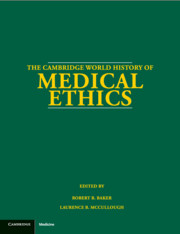Book contents
- Frontmatter
- PART I AN INTRODUCTION TO THE HISTORY OF MEDICAL ETHICS
- PART II A CHRONOLOGY OF MEDICAL ETHICS
- PART III DISCOURSES OF MEDICAL ETHICS THROUGH THE LIFE CYCLE
- PART IV THE DISCOURSES OF RELIGION ON MEDICAL ETHICS
- PART V THE DISCOURSES OF PHILOSOPHY ON MEDICAL ETHICS
- PART VI THE DISCOURSES OF PRACTITIONERS ON MEDICAL ETHICS
- PART VII THE DISCOURSES OF BIOETHICS
- PART VIII DISCOURSES ON MEDICAL ETHICS AND SOCIETY
- Ethical and Legal Regulation of Medical Practice and Research
- B Medical Ethics, Imperialism, and the Nation-State
- C Medical Ethics and Health Policy
- 59 Making Distinctions “Natural”: The Science of Social Categorization in the United States in the Twentieth Century
- 60 History of Public Health Ethics in the United States
- 61 Ethics and Health Policy in the United Kingdom and the United States: Legislation and Regulation
- 62 Ethical Issues in Organ Transplantation in the United States
- 63 Defining and Redefining Life and Death
- Appendix: Biographies: Who Was Who in the History of Medical Ethics
- Bibliography
- Index
59 - Making Distinctions “Natural”: The Science of Social Categorization in the United States in the Twentieth Century
from C - Medical Ethics and Health Policy
Published online by Cambridge University Press: 28 May 2012
- Frontmatter
- PART I AN INTRODUCTION TO THE HISTORY OF MEDICAL ETHICS
- PART II A CHRONOLOGY OF MEDICAL ETHICS
- PART III DISCOURSES OF MEDICAL ETHICS THROUGH THE LIFE CYCLE
- PART IV THE DISCOURSES OF RELIGION ON MEDICAL ETHICS
- PART V THE DISCOURSES OF PHILOSOPHY ON MEDICAL ETHICS
- PART VI THE DISCOURSES OF PRACTITIONERS ON MEDICAL ETHICS
- PART VII THE DISCOURSES OF BIOETHICS
- PART VIII DISCOURSES ON MEDICAL ETHICS AND SOCIETY
- Ethical and Legal Regulation of Medical Practice and Research
- B Medical Ethics, Imperialism, and the Nation-State
- C Medical Ethics and Health Policy
- 59 Making Distinctions “Natural”: The Science of Social Categorization in the United States in the Twentieth Century
- 60 History of Public Health Ethics in the United States
- 61 Ethics and Health Policy in the United Kingdom and the United States: Legislation and Regulation
- 62 Ethical Issues in Organ Transplantation in the United States
- 63 Defining and Redefining Life and Death
- Appendix: Biographies: Who Was Who in the History of Medical Ethics
- Bibliography
- Index
Summary
INTRODUCTION
Biological explanations do political work, writes anthropologist Margaret Lock, “creating the rules for belonging and exclusion” (Lock 1999, 83–113). Scientific criteria have long served as a means to create and justify social categories on the basis of “natural” distinctions. The biological sciences have been used to differentiate “good citizens” (those who, in a prevailing social context, will contribute to work, economic growth, and prosperity) from “bad citizens” (those who are criminally inclined, dependent, unhealthy, or likely to be costly risks). They have been used to identify membership in particular racial and ethnic groups for purposes of entitlements, and they have been used to explain inequalities by casting the differential treatment and status of particular groups as a natural consequence of essential, immutable traits.
The power of science as a means of categorizing people expanded in the late nineteenth century when clinicians and public health officials began to explore the etiology of disease in the distinctive features and susceptibilities of individual patients and their social milieu. Historian Matthew Jacobson describes how the increased focus on the individual had significant implications for many areas of social policy (Jacobson 1998, 113). Scientific fields such as craniometry and phrenology were developed to evaluate and categorize people according to their behavioral characteristics, susceptibility to disease, and ability to do particular types of work. They became tools in criminal investigations and provided guidelines for employment practices.
- Type
- Chapter
- Information
- The Cambridge World History of Medical Ethics , pp. 641 - 654Publisher: Cambridge University PressPrint publication year: 2008

